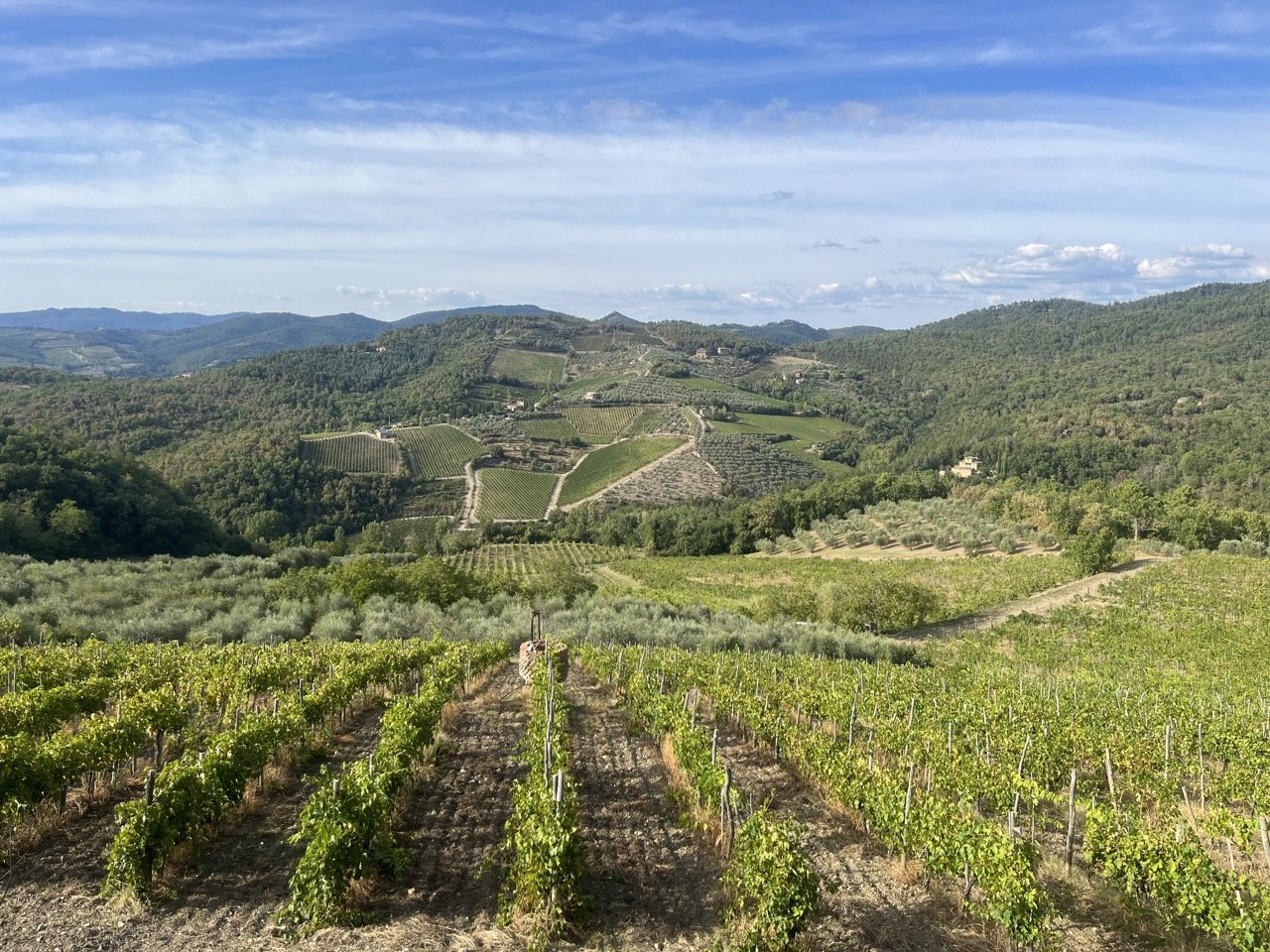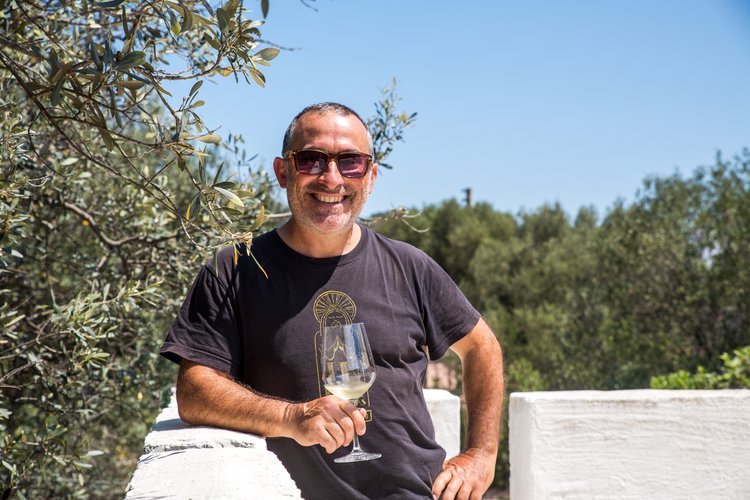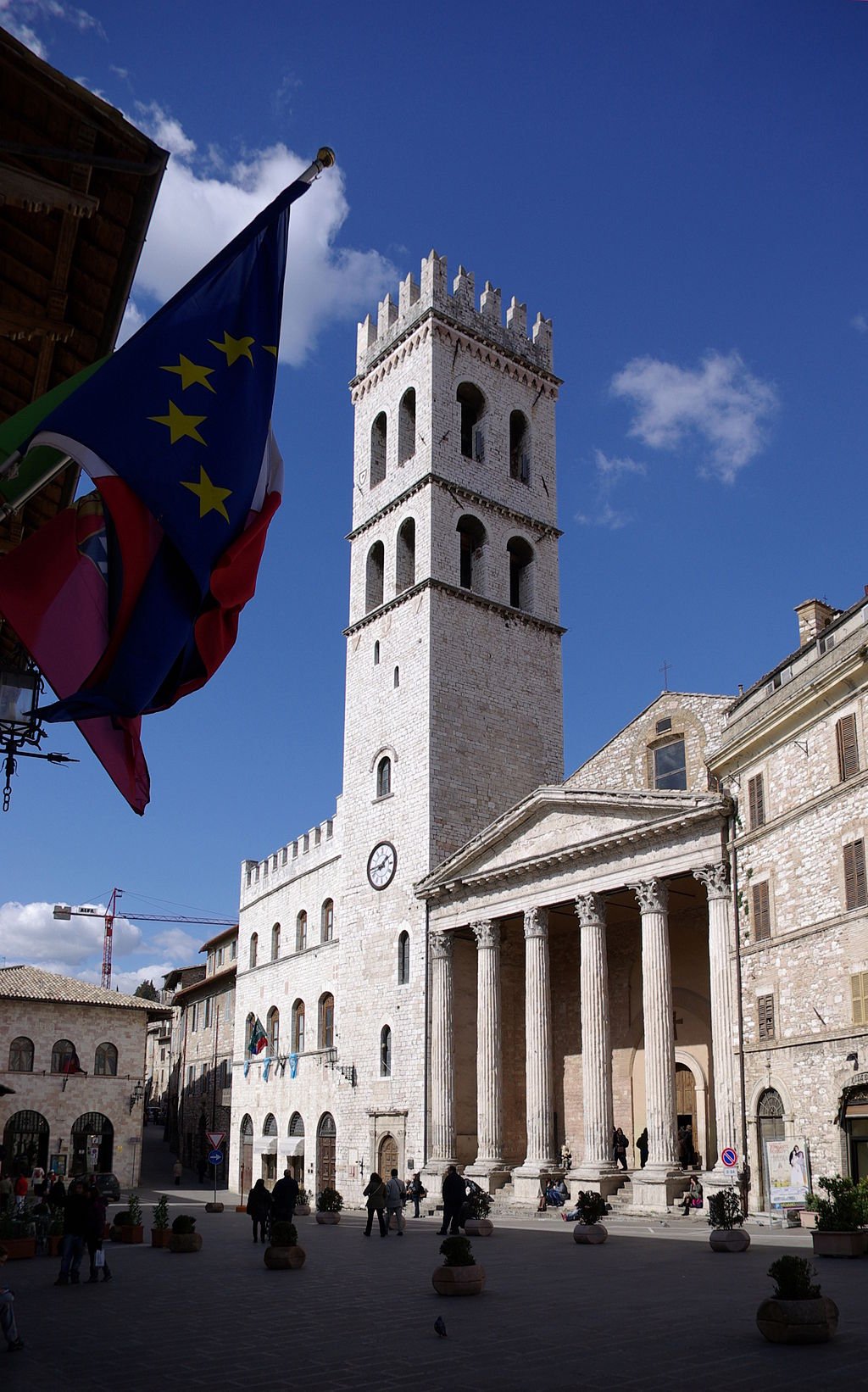Guide to Assisi, Italy
Affiliate disclosure: some of the links in this article are affiliate links. If you book using one of them, we’ll earn a small commission. All of our info is free to read and free of ads, so we appreciate it!
The birthplace of Saint Francis is one of the world’s most popular pilgrimage sites, welcoming as many as six million visitors a year. Despite the onslaught, Assisi is also one of the most beautiful towns in Italy, with houses of mellow, honey-colored stone and sublime views across the misty valleys below.
This town on the flanks of Monte Subasio thrived under the Romans. The beautiful façade of their Temple of Minever now graces the church of Santa Maria sopra Minvera, and that faces the ancient forum, now the Piazza del Comune.
It was the early Middle Ages, though, that put Assisi on the map. Francesco di Bernardone was born here in 1181, and, living in poverty and preaching kindness and humility, he soon became one of the most venerated saints in Christianity.
Francis is buried in the Lower Church of the huge Basilica di Francesco at one end of town, and masterful frescoes by Giotto in the Upper Church tell the story of this gentle soul who saw God’s presence in nature and preached to birds and sheep.
Francis is still a welcoming presence in this appealing town—you’re not likely to leave without a Saint Francis medallion or statue—and his spirit infuses the surrounding towns and countryside where he often preached.
Table of Contents


Why visit?
Many visitors to Assisi are following a centuries-old pilgrimage tradition and coming to pay tribute to Saint Francis. It’s unlikely anyone is going to come to Assisi without visiting the Basilica di San Francesco, but filing past the saint’s sarcophagus is not the only reason to step inside the massive church.
Giotto’s 28-scene fresco cycle depicting the saint’s life story in the Upper Church is one of the great masterpieces of the Renaissance and a top stop on any art lover’s tour of Italy.
Assisi is also a lovely place to spend time. The town has changed little since the Middle Ages, and its popularity on the tourist trail ensures that the palaces, churches, and houses of honey-colored stone are extremely well maintained.
Just walking through the streets into the handsome Piazza del Comune and up to the hilltop Rocca Maggiore is a pleasure, and the outlooks across the valleys below are sublime.
Assisi is also very well poised for a tour of northern Umbria. The drives to Perugia, Gubbio, Spello, Montefalco, Spoletto, and many other atmospheric and historic towns take less than an hour, and a trip into the countryside takes you across green valleys with the Apennines rising in the distance.
Where is Assisi?
Assisi is in northern Umbria, 175km (109 miles) south of Florence, 175km (109 miles) north of Rome, and 30km (18 miles) southeast of Perugia.
The town is set on the slopes of Monte Subasio and overlooks the tranquil Umbrian valleys and woods that give rise to the region’s nickname, the Green Heart of Italy.
In addition to Perugia, Assisi is also close to Gubbio, Spello, Montefalco, Spoletto, and other atmospheric and historic towns.
How to get here
Arriving by train
Rail connections to other parts of Italy are good, with direct trains running from Florence, and others that require a change in Terontola. In either case, the journey takes about 2 hours.
If coming from Rome, you’ll need to make a change in the town of Foligno, and the trip also takes 2 hours.
Assisi’s train station is actually in Santa Maria degli Angeli, on the plains below town, but it is well-connected by buses that run several times an hour for the trip up to Assisi. The bus takes about 10 minutes.
Arriving by car
By car, Assisi is about two hours north of Rome and the same travel time south of Florence. The A1, Italy’s main north-south highway, runs to the west of Assisi, and a trip from Rome or Florence requires leaving the autostrada and continuing on well-maintained secondary roads.
If you’re planning on renting a car, I always recommend using DiscoverCars. It’s a car rental website that include sofferings from all the major international rental companies as well as lots of smaller local agencies, which often have much better pricing. You can often find terrific deals.
Parking
Mojano and other well-marked parking areas on the hillside around the old town are connected to the center by a elevators and escalators.
One of the most convenient garages is in Piazza Matteotti, from which it’s an easy downhill walk to the Piazza del Comune.
Best time to visit
Photo: Hagai Agmon-Snir حچاي اچمون-سنير חגי אגמון-שניר, CC BY-SA 4.0, via Wikimedia Commons
If you’re planning to explore the surrounding towns and countryside while you’re in Assisi, the most pleasant time to visit is the spring, when temperatures are mild (often around 21℃ (70℉), days are long, and wildflowers are in bloom across the green landscapes.
Early fall is also nice, with lots of sunshine, and October temperatures are still around 19℃ (66℉) or so. Winters in Assisi are also fairly pleasant, with daytime highs in January and February often lingering around 10℃ (50℉).
In winter, the plains below town are often shrouded in fog, creating a magical sensation of Assisi floating in the clouds.
Weather, however, should not be as big a consideration as figuring out how to avoid the formidable crowds that you’ll often find here. The town is busy with pilgrims year round, especially in summer, and they often arrive by the busload.
Easter and the Feast of St. Francis, October 4, bring many visitors to town, as does Calendimaggio, a medieval, multi-day bash in early May.
Weekends are busy throughout the year, because Assisi is a popular day-trip and overnight getaway for Italians. So, if you can avoid the holidays mentioned above and visit during a weekday, that’s definitely your best bet.

Connect with Umbria travel expert Marco for help perfecting your itinerary, answers to all your travel questions, and fabulous local tips for a better visit!
How long to spend
You can comfortably see Assisi in just a day, which will give you ample time to visit the Basilica and some of the other churches, head up to the Rocca Maggiore (a medieval hilltop fort), and have a leisurely walk around town.
Apart from the Basilica, the town doesn’t have a ton of major sights, so you could even breeze in and out in just a couple of hours, depending on your travel style and level of interest in religious tourism.
Assisi is nearby to a number of other interesting towns though, so if you want to slow down and explore the surrounding area, you could even spend a few nights here. This would give you time to add in day trips out to towns like Gubbio, Spello, Montefalco, and other small towns in the vicinity.
Where to stay
If you decide to spend the night here, set your sights on Assisi proper rather than the modern town of Santa Maria deglia Angeli, located on the plains below. The lower town is not especially nice and many of the hotels there cater to busloads of pilgrims, so the atmosphere isn’t ideal.
Below are some of my favorite hotels in Assisi. Please note that the rates listed are for a double room with breakfast included, and that they can fluctuate with demand, potentially becoming quite expensive at busier times.
Hotels in Assisi also sell out well in advance, especially at Easter and around the October 8 feast day of Saint Francis.
Hotel Il Palazzo rambles across several floors of an old palace that’s been smartly redone with many comforts, best of all the soul-soothing views across the valley from many rooms. From 120 euros.
Hotel La Terrazza is not in town, but on a hillside just outside the old walls, and the rural setting comes with gardens and a pool. From 90 euros.
Hotel Umbra, a traditional inn tucked away in a little courtyard off Piazza del Comune, has a view-filled rooftop terrace and quiet and homey rooms. From 120 euros.
NUN Assisi Relais is the place to splash out, literally, in pools, hot tubs and a spa and in swanky and stylish accommodations carved out of an old convent. From 600 euros.

Restaurants and dining
Assisi classics include torta al testo, flatbread stuffed with cheese, vegetables, and meat, and porchetta, roasted pork. They’re the specialty at small cafes and stand-up bars around town, and they also appear on restaurant menus.
For a light meal, the best stop is Bibenda, an atmospheric wine cellar where Umbrian wines are served by the glass are accompanied by local cheeses and salamis. Drinks and small plates for two are from 20 euros.
La Stalla, in a converted stable in the countryside just outside town, is a favorite stop for rustic local favorites that include torta al testo and skewered meats cooked over an open fire. Dinner for two is from 60 euros.
The best bet for dinner with a view is Le Terrazze di Properzio, where the spectacle of the sun setting behind the valley compliments a menu of hearty pastas and grilled meats. Dinner for two is from 80 euros.
Umbrian classics are served in the rustic and charming beamed rooms of Trattoria Pallotta, in a little alley off Piazza del Comune. Dinner for two is from 80 euros.
What to see & do
1. Pay Homage to Saint Francis in the Basilica di San Francesco
Assisi’s main attraction is the imposing medieval Basilica di San Francesco, on a hillside at one end of town. The humble saint is interred in the Lower Church in a sarcophagus beneath colorful frescoes. A steady crowd of faithful files past, many on their knees.
In the light-filled Upper Church, a sublime, 28-part fresco cycle by Giotto tells the life story of this man who nine centuries after his death is still beloved for his kindness. Scenes that depict the saint renouncing his worldly goods, preaching to the birds, and giving his mantle to a poor man are set against scenes of Umbrian towns and countryside that have changed little since Giotto painted them in the last part of the 13th century.
2. Step into the Basilica di Santa Chiara
One of Francis’ most ardent followers was a young woman from a noble family, Chiara, or Clare. She renounced worldly goods at an early age and later founded the order of Poor Dames, known today as the Poor Clares. She is honored in a stark basilica, where a wax figure of her body is on eerie display.
3. Visit the 7th largest church in Christendom - the Basilica di Santa Maria degli Angeli-Porziuncola
The huge Basilica di Santa Maria degli Angeli-Porziuncola, on the plains beneath Assisi in Santa Maria degli Angeli, is built around the chapel where Francis renounced his worldly goods (the Porziuncola) and the cell where he died in 1226.
The makeshift huts that once surrounded the 9th-century Porziuncola to accommodate monks and pilgrims were cleared in the late 16th century to make way for the massive mannerist church, where the humble little chapel is engulfed within the huge nave.
A rose garden now grows next to the church on the site of the dense woods where Francis lived and famously preached to the turtle doves.
Photo: Kimahri88, CC BY-SA 4.0, via Wikimedia Commons
4. Take in the views from the Rocca Maggiore
A climb through the upper reaches of town leads to the mountainside Rocca Maggiore, a medieval fortress of bleached yellow stone. The far-reaching views across the Umbrian plains from the grounds steal the thunder from the fairly dull display of medieval weaponry inside the vaulted halls of the fortress.
5. Retreat to the Eremo delle Carceri hermitage
Another Francis-related stop is just outside of town, on the slopes of Monte Subasio. The Eremeo delle Carceri is a hermitage in the woods where Francis often retreated to pray and commune with nature, sleeping in a cave on a stone ledge.
Over the centuries a friary, chapels, and other buildings have surrounded the cave, but the spirit of the saint still permeates this peaceful spot.
6. Enjoy the peaceful views from Piazza Superiore di San Francesco
When you leave the Upper Church of the Basilica di San Francesco, you’ll be in the Piazza Superiore di San Francesco. Walk to the far, upward end of this airy expanse, carpeted with a well-manicured lawn, for a soothing view back to the church, with the mountains and valley in the distance. The busy Bar San Francesco, just off the square, is a pleasant stop for a coffee and pastry.
7. Do some people watching in Piazza del Comune
This lively square is the center of town, with a large fountain and surrounded by cafes. If you get here by walking along Via San Francesco from the Basilica di San Francesco, you’ll pass two important landmarks as you enter the square:
The 13th century Torre del Popolo, an elaborate bell tower, and next to it an amazing sight, the beautifully preserved columns and pediment of the Temple of Minerva, from the first century b.c. The temple now serves as the façade of the ornate, 16th-century church of Santa Maria sopra Minvera.
The Church of Santa Maria sopra Minerva in the Piazza del Comune. Photo: Berthold Werner, Public domain, via Wikimedia Commons
8. Pay a visit to Cattedrale San Rufino
Long before the Basilica di San Francisco was built, the Cattedrale San Rufino was the town’s main church. In fact, Saint Francis and Saint Claire were baptized in the stark Romanesque interior beyond the entrance carved with lions and griffins, and they often prayed here. Another presence is Saint Rufino, a third-century bishop of Assisi who was martyred. His remains are beneath the altar.
Cattedrale San Rufino. Photo: Marco Ober, CC BY-SA 4.0, via Wikimedia Commons
9. Just walk around and enjoy yourself!
Now take some time to wander around the cobbled lanes of this attractive hill town of honey-colored stone, enjoying the quiet atmosphere and popping into the little squares and alleys. Every once in a while you’ll come upon a sight like the pretty Fontana di San Rufina, or, at the end of Via Santa Chiara, a Roman gate.
10. Join in some local celebrations
Assisi ushers in spring with Calendimaggio, a medieval, multi-day bash in early May with costumed lords and ladies, crossbow competitions, and a lot of banner-waving pageantry.
Nearby Spello follows suit a few weeks later on the Feast of Corpus Cristi with the Infiorata, when townsfolk create a mile-long carpet of fresh flowers along the streets, fashioning the arrangements into biblical scenes.

Connect with Umbria travel expert Marco for help perfecting your itinerary, answers to all your travel questions, and fabulous local tips for a better visit!
How to spend a day in Assisi
Morning
Begin the day on the plains below town in the Basilica di Santa Maria degli Angeli-Porziuncola, the seventh-largest church in Christendom. The basilica is holy ground for pilgrims, as the complex surrounds the chapel where Saint Francis renounced his worldly goods (the Porziuncola) and the cell where he died in 1226.
Once you’ve made the trip up the hill to Assisi, make your way to the broad Piazza del Comune for a coffee to admire the columned façade of the church of Santa Maria sopra Minvera, what remains of a Roman temple.
From here, well-trodden lanes lead to the Basilica di San Francesco and the town’s main attractions—the tomb of Saint Francis in the lower church and Giotto’s masterful frescoes telling his life story in the Upper Church.
A short walk across town brings you to the Basilica di Santa Chiara, where Assisi’s other saint, a follower of Francis, is buried.
Afternoon
A good choice for lunch is torta al testo, flatbread stuffed with ham, cheese and other fillings and sold at casual eateries around town. Now that you’ve seen the major religious sites, take a walk to enjoy Assisi’s welcoming, hill-town ambiance.
A climb in an upwards direction will bring you to the Rocca Maggiore, a medieval fortress with far-reaching views across the plains below.
Evening
Piazza del Comune is the popular evening gathering spot for a cocktail and short walk around the square. A good follow-up is a dinner of hearty Umbrian classics, and that often means pork--prosciutto from the mountain town of Norcia and umbricelli alla norcina, pasta with a hearty sauce of pork sausage, washed down with local reds from the nearby Montefalco vineyards.
Nearby towns to visit
1. Spello
When visiting Assisi, you might want to include a short side trip to Spello, just 15 minutes down the road. This small town will charm you the minute you step through the gates into the flower-bedecked lanes.
Another one of Umbria’s great works of art is here, in the church of Santa Maria Maggiore, where Pinturicchio (the Little Painter) filled the Baglioni Chapel with delightfully detailed frescoes portraying the boyhood of Christ set against Umbrian landscapes. Apart from their technicolor beauty, the scenes stand out as a bit of medieval damage control.
The powerful Baglioni clan commissioned them to get back into the good graces of the church after a family feud devolved into the so-called Red Wedding, a frenzied bloodbath that left behind a pile of butchered corpses.
An aerial view over Spello. Photo: Hagai Agmon-Snir حچاي اچمون-سنير חגי אגמון-שניר, CC BY-SA 4.0, via Wikimedia Commons
2. Perugia
Perugia is the capital of Umbria, and with 160,000 residents, the largest city between Florence and Rome. Busy and cosmopolitan as this bustling city is, Perugia is a medieval hill town at heart, and the old city crowns a ridge high above the Tiber Valley. Adding to the appeal of the beautiful squares and palaces is the youthful buzz of many university students.
Spend a day visiting the excellent museums and beautiful churches and exploring the twisty lanes that lead on and off the main street, Corso Vannucci.
Stops include the Galleria Nazionale dell’Umbria, on the top floors of the heavily medieval Palazzo dei Priori, where galleries showcase the great works of Umbrian artists from the Middle Ages and the Renaissance. The Nobile Collegio del Cambio next door preserves the meeting rooms of the town’s medieval money-lending guild, providing a glimpse into 15th-century office life.
The cobbled lanes that crisscross the old town often become steps as they climb hills and drop into ravines. A view-filled ramble takes you along Via dell’Acquedotto, across the top of a 13th-century aqueduct with a panorama of the town and valley unfolding as you cross.
Another walk leads underground, into the remains of the medieval city beneath Piazza Italia, where a series of escalators and walkways descends through a maze of vaulted chambers and old streets. Peruginos take their evening passeggiata up and down Corso Vannucci, so join them before heading back to Assisi.
3. Lake Trasimeno
Lago Trasimeno, the fourth largest lake in Italy, is less than an hour north of Assisi. The shallow, blue waters set against green hills, vineyards, and olive groves lap against pebbly beaches at Passignano and Castiglione del Lago, both within easy reach and where you can rent boats and bikes, swim, or just enjoy the views across the waters.
Boaters set their sights on Isola Maggiore (served by ferry), a charming little outcropping with some nice cafes and places for a refreshing dip.
Isola Maggiore in Lago Trasimeno
4. Deruta
Pretty little Deruta, about a half an hour southwest of Assisi, has a few worthy landmarks, but for most visitors the frescoed Gothic churches take second place to the town’s famous ceramics, or maiolica.
About 300 workshops in the little town create the beautiful pieces, using age-old firing, glazing, and painting techniques. The output is for sale in shops and studios around town.
5. Gubbio
With its crenellated palaces set against dark hillsides, Gubbio, less than an hour north of Assisi, is a thoroughly medieval-looking place, though the Romans who conquered the Etruscans settled here 2,000 years ago and left behind one of the largest theaters from the ancient world.
Begin your explorations in the town’s movie-set-worthy showpiece, Piazza Grande, a dramatic expanse of brick anchored by the heavily Gothic Palazzo dei Consoli (town hall) and opening on one side to soothing views across Umbrian landscapes.
Step inside the Palazzo dei Consoli for a look at the Eugubine Tablets, from around 200 b.c.e., a sort of Rosetta Stone in which the Umbri language is transposed in Etruscan and Latin letters.
Saint Francis also spent time in Gubbio, and you’ll encounter him over lunch at the storied Taverna del Lupo, where frescoes tell the legend of the saint taming a ferocious wolf who was devouring townsfolk (lunch for two will be about 70 euros). After lunch, hop onto the Funivia Colle Eletto for a ride up Monte Ingino.
As you enjoy the breezy ascent in one of the open-air cages, keep in mind that every spring during the Corsa dei Ceri, costumed teams shoulder huge statues of saints mounted on battering ram-like platforms and race up the slopes. In December, Eugubini (as Gubbio residents are called) light up Ingino in the shape of the world’s largest Christmas tree.
6. Bevagna
Walled Bevagna, less than half an hour south of Assisi, is an exception among Umbrian towns—it’s entirely flat, built in a valley alongside the Teverone River.
Saint Francis famously preached to the birds in green riverside pastures just outside the town walls, and the stone on which he stood to do so is in the church of San Francesco.
7. Montefalco
This lovely town is famous for wine, especially the reds made from the Sagrantino grapes that grow in vineyards that run right up to the walls. You can taste the output at wineries along the Strada Del Sagrantino wine trail.
Even without the benefit of a glass or two the place is intoxicating, and a maze of lanes surrounds a circular piazza lined with proud medieval palaces.
Just off the Piazza is the town’s other treasure, a fresco cycle in the deconsecrated church of San Francesco that portrays the life of the saint in touching vignettes. Detailed scenes capture the magic of the Umbrian landscapes that stretch in all directions beneath the town.
More Umbria travel info
For more advice on planning a trip to Umbria, check out our other guides and itineraries!



























